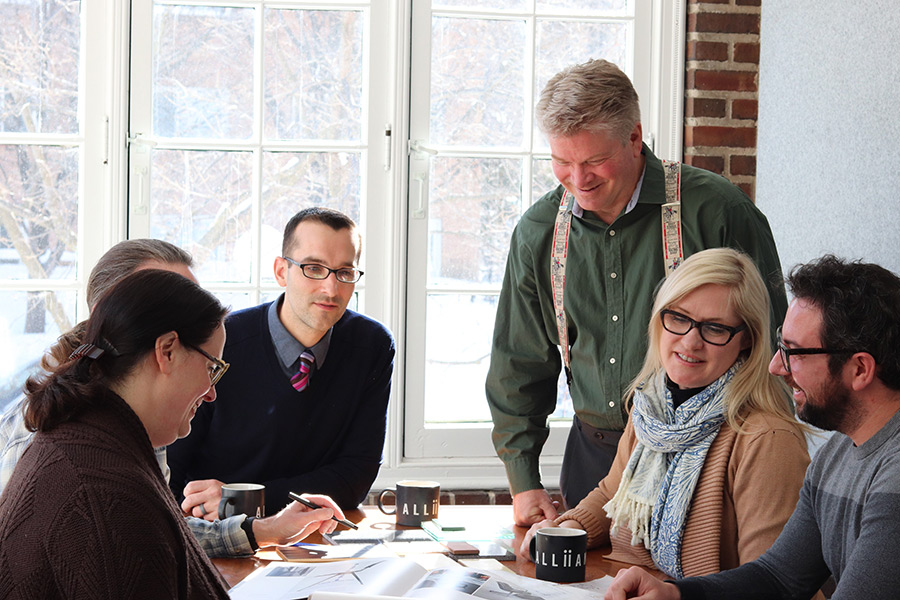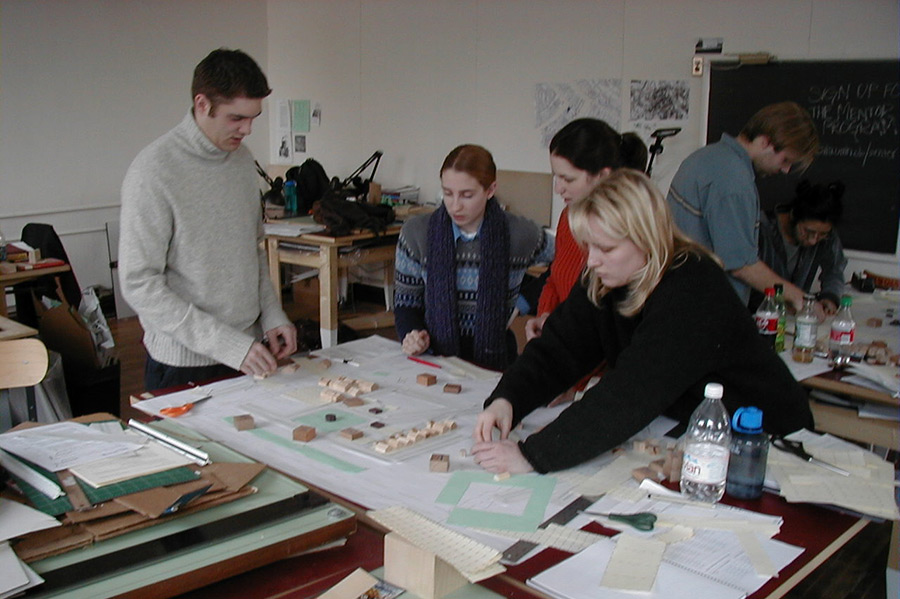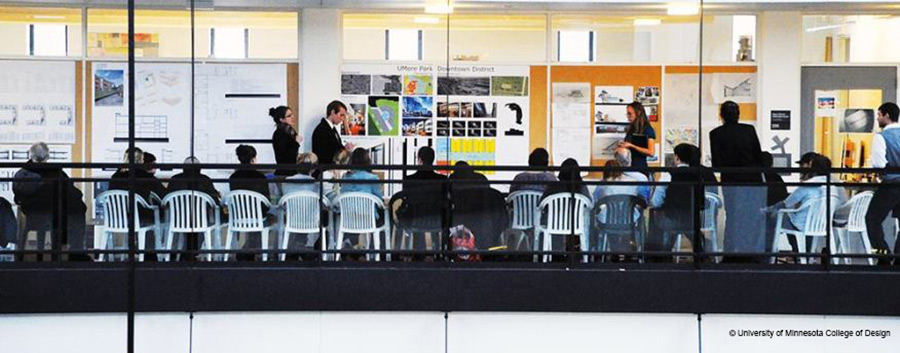
Teaching Design Studios During COVID-19
in Perspectives
by Anna Pravinata, AIA, LEED AP and Justin Wilwerding, MA, CID, IDEC
The tsunami of change wrought by COVID-19 has required colleges and universities to rapidly pivot to sustain the education process. In particular, design studio courses, such as architecture, landscape architecture, and interior design, are historically problem-based, collaborative, and hands-on courses. These courses foster creativity through interactions between students and the spontaneous collision of ideas. Student interactions are facilitated through group sketching exercises; the development of physical models; using material samples and physical objects; and visiting project sites. These are critical elements of a design curriculum that are needed to ensure student success. Design education often uses online learning platforms, but nothing could have prepared design faculty to deliver concepts about how people use space, without using any real spaces.
To understand how design faculty creatively redesigned their design studio courses to address the pandemic, we interviewed six design faculty members from three different institutions:
- Nina Ebbighausen, AIA, LEED AP – Adjunct Associate Professor, School of Architecture, College of Design, University of Minnesota
- Choy Leow, AIA – Adjunct Instructor, Architecture Program, Dunwoody College of Technology
- Joe Favour, ASLA – Professor/Department Head, Landscape Architecture, College of Design, University of Minnesota
- Meghan Hendrickson, CID – Teaching Specialist, Interior Design Program, College of Design, University of Minnesota
- John Dwyer, AIA – Program Manager Architecture/Interior Design, Dunwoody College of Technology
- Maureen Monhollen, IIDA, NCIDQ – Assistant Professor of Interior Architecture, Chatham University
Out of these interviews, the following themes emerged:
TECHNOLOGICAL BENEFITS AND LIMITATIONS
The topic of curriculum delivery through an on-line channel was discussed on whether a “synchronous” (meeting at the same time) or “asynchronous” (prerecorded or text-based information) approach to learning was most effective.
Nina Ebbighausen, noted that in studio classes “…learning how to work together is a big deal.” A synchronous approach using Zoom allowed students and the instructor to actively collaborate using shared platforms.
In contrast, Joe Favour commented that he relied heavily on asynchronous approaches to deliver curriculum concepts, providing students with a maximum degree of flexibility. Additional “office hours” through Zoom meetings supported one-on-one interactions with students. Asynchronous approaches seemed to accommodate more diverse learning styles. Maureen Monhollen, recorded her lectures which allowed an international student to re-watch the lectures multiple times and discuss specific portions that the student did not understand due to a language barrier.
According to John Dwyer Dunwoody had, coincidently, developed an equity and diversity plan prior to the pandemic. As a part of the plan, each student was given a laptop with the same software, e.g. Revit and Microsoft suites, installed. This helped ensure that students had access to shared technology platforms and limited their use of non-standard technologies. Microsoft Teams also facilitated collaboration for some of the coursework. Choy Leow noted that difficulties arose from the lack of equal access to high-speed internet and that this inequity was sometimes a “heart-breaking” challenge for students. Nina pointed to a limitation in delivering coursework in a remote synchronous format; the likelihood that students may reside in different time zones means that a class offered at 1:00 PM in the instructor’s time zone would require a student to connect at 2:00 AM if they are in Beijing.
CONNECTING STUDENTS AND FOSTERING CREATIVE INSIGHTS
Design studios rely on “collaborative problem-based” instruction which requires students to collectively grapple with multi-layered problems. Many faculty members felt that the problem-based learning activities critical to design were difficult to translate remotely.
Meghan Hendrickson felt that effective student-to-student collaboration could be facilitated through “Zoom break-out rooms,” providing opportunities for peer mentoring, group critique, and one-on-one critiques between students and with the faculty.
Nina and John indicated that there were significant differences in how students learn in a physical classroom versus in a virtual format. They noted that remote learning limits opportunities for “accidental” learning experiences and in-class innovation. Nina indicated that there are different emphases between “noumenon,” abstract concepts, and “phenomenon,” experiential learning, in face-to-face learning as opposed to distance learning.
Joe said that digital collaboration can level the playing field for introverted students who have some reluctance to contribute in class. He added that digital collaboration also provided more access to practicing design professionals for design critiques, thus broadening the design conversations. In contrast to the possible advantages of remote learning, he also noted that student success was, in part, the result of whether students had a strong “internal-dialogue” and could guide themselves in a remote learning context, or needed more dialogue with instructors or fellow students (outer-dialogue).
IMMATERIAL MATERIALS AND SPACES
Teaching design is inevitably about materials and spaces. We asked our panelists, “How have you handled the physical aspect of design curriculum; the learning about how senses (touch, hear, see, etc.) impacts design?” The hands-on material nature of design education engenders concerns over “making” and the use of the maker labs on campus. Meghan commented that access to “making tools” has been very limited or non-existent for some students. Nina noted significant difficulty during the early days of quarantine regarding accessing common materials in a timely manner. This presented a challenge to faculty members regarding how students could acquire both skills and experience in making, and the meaning of making. Distance learning limited the abilities of students to use both traditional making tools and avant-garde making tools such as three-dimensional printers.
Most faculty members commented that they have to be thoughtful about design explorations through physical models due to the limitations above. But sharing digital models through Moodle, Microsoft Teams, or Google Drive online platforms seem to transfer well to virtual learning.
MENTAL HEALTH ISSUES ASSOCIATED WITH REMOTE INSTRUCTION
One topic that emerged spontaneously from the discussions concerned student health and wellness, particularly issues of mental health. Maureen noted that the isolation resulting from remote learning was hardest on extroverted students. She offered the view that colleges and universities may be least prepared for these kinds of issues. Similarly, Nina noted that the COVID crisis is having an emotional and psychological impact on students. More than ever before, the role of the instructor has broadened to address deep human concerns and supporting students in emotional issues, family issues, etc.
WHAT WILL CHANGE IN DESIGN STUDIOS POST PANDEMIC?
We discussed possible changes in studio spaces used in the design program if the COVID crisis continues. Joe commented that there is uncertainty about whether live studio instruction will be possible during the pandemic. There are problems with shared desks used by many students and the “messy” nature of design process. He foresees that going forward, physical studio spaces will be influenced by a broader experience with digital technologies, commenting that the pandemic, “… throws out this model of sharing and puts …[it] in a really… questionable light, how would students share desks if we have this kind of on-going virus issue… I don’t think we have great answers.… So my hope is …we can figure out a way to share more, …but maybe we’ll just have to live on-line with studios for a while.”
Maureen commented on the important role the physical campus plays in delivering the “college experience.” This college experience is important to professional identity, and to the development of student cohorts that are collaborative and mutually supportive. John spoke about the range of considerations associated with modifying classes and classrooms to sustain a safe learning environment. Issues such as the maximum occupancy of a classroom to sustain proper social distancing recommendations, and face-to-face instruction with staggered schedules are on the table. Time becomes another part of the puzzle; Dunwoody is trying to understand how long students should remain on campus in a single day (due to viral load considerations) and the time required to complete a thorough cleaning between classes. The making and hands-on culture of design studios prompted further consideration, in Dunwoody’s planning for fall term, equipment might need to be more widely distributed instead of residing in special labs to reduce the number of students using the same space. And lastly, Meghan commented that it seems important to look to the on-going research into the transmissibility of interior surfaces and anti-microbial properties of materials.
The comments of these faculty make it clear that design instruction during COVID-19 has been a creatively fraught endeavor. The key take-aways as we are looking forward to fall are:
1. Focus on hybrid learning. Understand what portion of the curriculum can be delivered easily and effectively through pre-recorded online lectures and which portions benefit most from physical interactions. Physical, on-site learning should focus on building community (student cohorts) and hands-on making skills and experience.
2. Leverage virtual learning. Foster an interdisciplinary design practice by broadening participation of design professionals from a wider geographic areas.
3. Be mindful of students’ mental health. Be empathetic of different learning styles and needs for social interactions.
4. Focus on equitable access to learning (virtual or physical). Disadvantaged students may need more financial help to access high-speed internet or safe home environment.
The evolving nature of the pandemic will continue to deliver new insights and foment new approaches to teaching and learning in design. The future culture of design studios will likely evolve to one that centers around the students, their learning styles, and their needs to be successful.
We would like to thank our panelists:
- Nina Ebbighausen, AIA, LEED AP – Adjunct Associate Professor, School of Architecture, College of Design, University of Minnesota
- Choy Leow, AIA – Adjunct Instructor, Architecture Program, Dunwoody College of Technology
- Joe Favour, ASLA – Professor/Department Head, Landscape Architecture, College of Design, University of Minnesota
- Meghan Hendrickson, CID – Teaching Specialist, Interior Design Program, College of Design, University of Minnesota
- John Dwyer, AIA – Program Manager Architecture/Interior Design, Dunwoody College of Technology
- Maureen Monhollen, IIDA, NCIDQ – Assistant Professor of Interior Architecture, Chatham University



